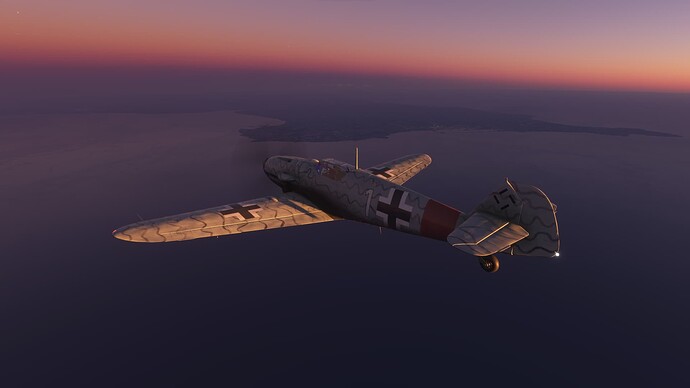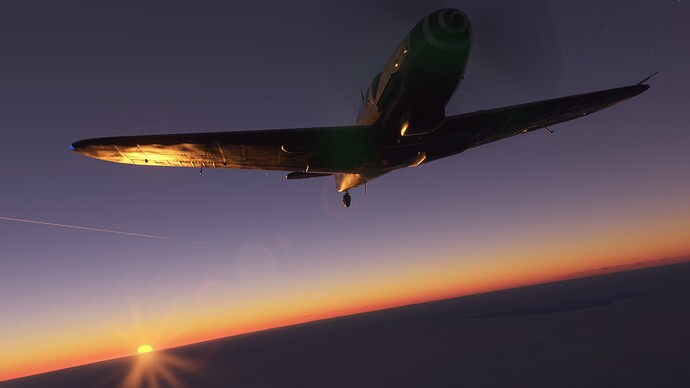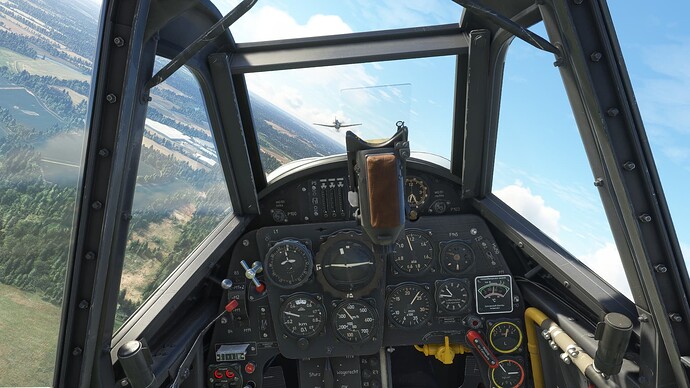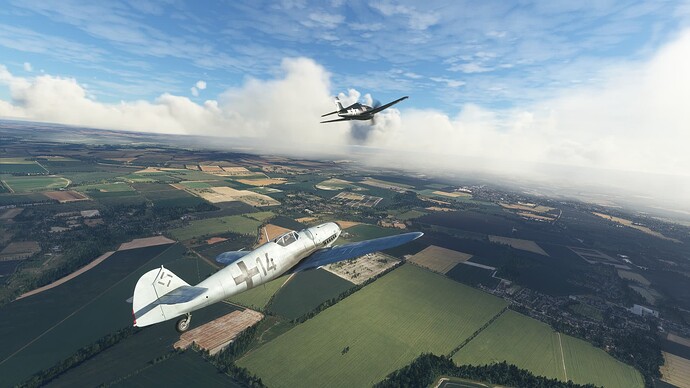Omg how cute is this 
@ravenwings27 Thank you, I’m glad you like it =) For the spectator view I use the showcase camera. You can lock it on the aircraft and then move it to a location of your liking.
Every single landing I’ve had to far in the Messer has been terrifying. Mind you, take-offs aren’t much better!
Seems a trend with warbirds that they are actively trying to kill their “own side”. That’s kind of the opposite of what they were needed for isn’t it? ![]()
Or it’s a in-built way to sort the men from the boys.
The last thing you’d need as a pilot after returning alive from intense battle is that final fun challenge of not killing yourself at home base!
one thing i dont like is the ground handling, proper mode i cant get to work at all i have pedals with toe brakes, it woks on spit and hellcat fine but on 109 simply doesn’t work, in simplified mode its a handful and while it works most of the time sometimes it simply refuses to turn no matter what i do and tail wheel is UNLOCKED
which brings another point tail wheel lock sometimes works and sometimes doesnt ive had to do it 3 or times before to unlock it after a landing no idea why its being werd
Did some changes to the standard cameras views and added two views accessible via the instrument views that help you looking out right and left of the nose during taxi, landing and take-off
https://flightsim.to/file/56720/flying-iron-messerschmitt-bf-109-g-6-better-cameras
Practice makes perfect. As the manual states the angled landing gear on this makes it a real ■■■■■ to handle on the ground due to the way the forces shift around when turning or braking. That big V12 up front also really wants to turn the plane left constantly so you gotta be on top of that at all times. I find short bursts of throttle whilst pushing the rudder in one direction plus some toe braking works best to turn it but always be careful. I also use a lower prop setting than recommended in the manual and checklists, 12 o clock seems a bit too much really, 11 or half 11 is a lot more sedate.
And some unrelated screenshots:
I never knew that the Germans invented the cyberpunk aesthetic during WW2:
And in other unrelated news the range figures in the tablet seem way off, like there should be a decimal in there and the time also seems to go down quite a bit faster than it should, even in a steady cruise at 1.0 ata. Landed at my planned airport with about 4 gallons left in the tank.
Locked and loaded! The problem is my setup. No rudder pedals and I haven’t tailored my joystick curves to optimal response for the 109. I can’t really make the constant fine adjustments to rudder/ailerons that the plane requires on takeoff. Same basic issue on landing - the control isn’t fine enough to effectively stabilize on the ground (especially with the sim’s jarring transition between air and ground physics…) I’m okay with “cheating”. (You just need to remember to remove the default aileron trip in the flightpad, as the manual says…)
These are some aspects about operating the Bf 109G that real world pilots who have flown the type have mentioned in modern pilot reports and interviews I’ve seen over the years, including Mark Hanna, Dave Southwood, Charlie Brown, Volker Bau, Klaus Plasa, Rick Volker, Bruce Winter, etc.
Taxiing -
Because the center of gravity in the Bf 109 is quite far aft, in reality it causes the aircraft to be very tail-heavy on the ground and difficult to turn. According to real world pilots, the only way around this is to use short bursts of power, a foot full of rudder and toe brakes, and even down elevator to lighten the tail. Unlike the Spitfire, where if you get too heavy on the brakes it will easily nose over, the '109 doesn’t pose the same risk. I haven’t sat and tested it yet, but in reality, because the radiators are so small, current Bf 109 operators have mentioned that you only have about 12 minutes from startup until when you will need to be taking off, otherwise you run the very real risk of overheating the engine/coolant. This is the reason mentioned as to why neither of the Bf 109s at Oshkosh last year flew in the airshow.
Takeoff -
Real world Bf 109 pilots describe that on takeoff, you start with the control stick to the far right and slightly forward, to counter the p-factor, and then as the tail comes up you adjust the position of the stick based on feel. Just as in reality, the big thing to watch out for is to not add more power than you can compensate with rudder. You also don’t want to have to be full right rudder when the tail lifts, otherwise there won’t be any remaining to be used when it starts to veer anymore to the left. With the elevator trim set to 1-degree nose up (-1 on the indicator), flaps set 20-degrees, tailwheel locked, brakes off, stick to the right and slightly forward, you start to gradually increase power, rudder pedals just about full right to compensate, and you continue to increase power as you feel it can be controlled. Once there is enough airspeed on the dial, you can feel that you’re not having to carry as much right rudder anymore and you can continue to increase the throttle to full takeoff power (1.1 ATA or greater), gently raise the tail, and by 180 kph you’re flying. 1.1 ATA is a common takeoff power setting among DB 605-powered Bf 109 operators today (to save the engine), going back to when “Black 6” flew in the 1990s, which is quite a lot less than the power available and should be all that is needed on takeoff. The late Mark Hanna would joke that Walter Eichhorn’s approach to take off in the '109 was to hold full right rudder and simply vary the throttle to control the swing.
Cruise -
The standard cruise setting used by modern operators today is 1.05 ATA / 2100 RPM, which is spot on in the sim. At these power settings, and the radiator doors closed, the airspeed in level flight should be about 430 kph, and the elevator trim setting should be at 0, and both of which are right on with the FlyingIron '109.
Aerobatics -
The real Bf 109G is considered to be very maneuverable and benign at low airspeeds, despite its high wing loading. This is because of the wing slats that automatically deploy to give the wings more surface area when needed. However, as the airspeed builds the control surfaces tend to get heavier/stiffen up, especially in pitch. This is another area that is captured so well by the FlyingIron flight model. According to one of the pilots that flew the Bf 109G “Black 6” in the 1990s, Dave Southwood, he stated that it could be very tiring to fly it through an aerobatic display because of the amount of pitch force per G during a vertical maneuver. He stated further that at 520 kph, it is possible to pull into a 4G climb with just one hand, but it is more comfortable to use both hands on the stick for looping maneuvers. You’ll notice with the FlyingIron '109 that as you enter a loop or half Cuban 8, at a proper entry speed of about 520 kph, it takes quite a pull on the joystick to enter the vertical, but as the airspeed bleeds off, the elevators become lighter and you won’t be using as much back force. When the Bf 109G “Black 6” was flying, 1.15 ATA was used as the power setting for aerobatic displays, with the prop switched out of automatic and manually set to 2400-2500 RPM in order to prevent overboosting. Dave Southwood, in his aerobatic displays in “Black 6”, would make the run-in at 420-450 kph. Bruce Winter, who owns and flies both an authentically-restored P-51D and an authentically-restored Bf 109G-6, mentions that the difference in linkages/cables for the control surfaces in the Bf 109 makes its control behavior noticeably very quick/responsive.
Landing -
Every real world pilot that talks about flying the Bf 109 makes sure to mention that it is not an aircraft to land in a two-point attitude, because of the geometry of the landing gear. If you were to do so, it will very likely want to veer off the runway, in either direction, and cause you to end up in a crumpled mess off the side of the runway. So you always, always land it in a three-point attitude. The Bf 109 lands at a rather low airpseed, roughly around 145 kph at touchdown, and if you set it down at that airspeed, true-to-life, it just settles onto the runway beautifully and tracks well.
Gonna have a bit of a meandering ramble here so feel free to ignore it!
IRL I’m not really a Bf 109 fan. As a Brit I grew up worshiping the venerated Spitfire, and the 109 was always the bad guy to the Spit. Plus I think the 109 is kinda ugly, so yeah really not my cup of tea. I kinda ignored it in the many flight sims, combat and civilian, that I’ve played over the past 3 decades. Sure I’d take one up on occasion in the old IL2 games or whatever but it was kinda rare. ‘Meh’ was my general feeling towards the 109.
FlyingIron first teased the 109 in development over a year ago on a post on their website and I can’t say I was that impressed, ‘oh look another 109 in a flight sim: yawn,’ was my reaction and I was much more interested in the Fw 190 they also teased. I even considered skipping buying the 109 as I really just didn’t care for it that much.
But then, as evident in this thread, when they released it I thought ‘why not?’. these guys have been knocking it out of the park with their releases and every new release has been an improvement on the last. And the Bf 109 is quite simply one of the best simulated planes I’ve had the pleasure of fling. Can’t really explain why exactly but I absolutely love flying this bird. The chaps at FlyingIron have gone above and beyond with this outstanding plane. It might even be making my change my mind about the 109 in general (I still think it looks butt ugly though. ![]() )
)
So cheers to @Donny6171 and the rest of the team who worked on this wonderful bird!
I’ve almost managed to do it ![]() Was taxying along without a care in the world and maybe I was going a bit too fast. There was a turn approaching that I didn’t notice so I slammed on the brakes and the tail lifted up. Thought I was gonna nose over but managed to control it. It was quite alarming!
Was taxying along without a care in the world and maybe I was going a bit too fast. There was a turn approaching that I didn’t notice so I slammed on the brakes and the tail lifted up. Thought I was gonna nose over but managed to control it. It was quite alarming!
Thanks for the informative post btw. I noticed the controls locking up in high speed dives as well and was well impressed even if I did almost crash, lol. I really need more practice landing as I’ve crashed it about 1/3 of the time and the rest I bounce like crazy. My last one was in the dark as well which was even more nerve wracking than usual. I bounced so high that the sim probably counted it as a second take-off, but the gear survived contact when it came back down thankfully so I’ll count it as a win.
Thank you John, for the very detailed write up. I first saw Red 7 fly when I was 10 years old and she got me hooked on the Bf-109. Since then, I’ve read and watched pretty much everything I could find on the 109.
A few years ago, I had the chance to meet Walter Eichhorn who was very kind to take a good 2-3 hours to talk about his flying career, show me his AT-6 and among many other things talk about the 109. One thing he told could give a bit of a perspective on the 109.
He said that in many ways a P-51 is easier to fly than an AT-6, for instance better forward visibility on the ground due to the narrower nose. But if you want to fly the 109 the AT-6 is only about halfway there in terms of difficulty. Before he started flying the 109 he met with Bubi Hartmann, who gave him a list of what not to do when flying the 109.
Walter is a true inspiration, he will turn 87 next month but still flies his Extra on an almost daily basis. Last weekend at a local airshow he got a nice surprise from the Flying Bulls who send his old AT-6 (he sold it about 2 years ago). In the evening they took off with him in the back. The maneuvers / sequence during the display looked very familiar…it was Walter flying the whole time.
I hope you don’t mind me going off topic for so long. To get back on topic, here are a few screenshots from today. The 109 is truly represented wonderfully. Every flying characteristic and quirk I’ve read about is there and it really keeps you on your toes.
Honestly… FlyingIron’s BF 109 G-6 is so good. I hope one day FlyingIron releases a P-51D. …and… I pray that their " first 4-engined aircraft for MSFS…" is the Boeing B-17G. ![]()
It’s not pretty, but I thought I would record a simple flight around Duxford. I skipped the run-up, and also the aerobatics were purely thought up as I went (I’ve done better, more stable, loops just about every other time - the slats kept popping in and out because I wasn’t as smooth as I should have been - usually they only slide out once, as you go around the top, and then back in as you enter the down line). The touchdown speed on landing is also faster than it should be.
Oh my goodness! No wonder we see you crashed all the time ![]()
I don’t mind this kind off topic. I would like to know what Bubi told Walter not to do in 109 ![]()
Release elevator input significantly on top of the loop. Due to the stiff elevator at high speeds one tends to hold the stick fully back for the first part of the loop - and if you don’t release the pulled-back-stick, she’ll do an accelerated stall on top, usually folled by a snap roll or a spin.
The slats will come out on top at around 225 km/h, and if you pull carefully, she’ll get over the top nicely at 200 to 220 km/h. If you get slower, no problem either, but be prepared to input lots of right rudder to keep her from yawing on top of the loop.
I’ts possible to fly tight loops with an entrance speed of 420 km/h.
Good luck practicing! ![]()
A P-51D would indeed be a wonderful stablemate to go with the Bf 109G-6. I have a couple of the Asobo Mustangs but they don’t appear to have autopilot (quite helpful for long escort missions) and the fuel drains very oddly (once you switch off the center or right tank they seem to automatically drain down into the left tank).
As far as Aeroplane Heaven is concerned, they have shown very little interest in supporting their releases and I’ve heard their Mustang suffers from poor sounds.
I so, so want a B-17! I would prefer the F model but I’ll gladly take the G. From reading the tea leaves, I have hope that the future will include a B-17 from FlyingIron, and I’ll be first in line!!! ![]()
![]()
![]()











